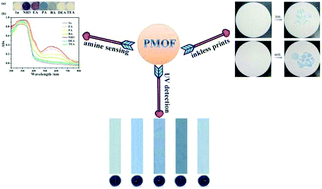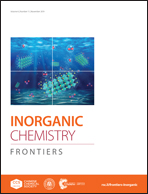A novel multifunction photochromic metal–organic framework for rapid ultraviolet light detection, amine-selective sensing and inkless and erasable prints†
Abstract
Herein, a multifunctional photochromic two-dimensional metal–organic framework (PMOF), [Zn(bcbpy)0.5(pma)0.5(H2O)]·3H2O (1), was synthesized (H2bcbpy·2Cl = 1,1′-bis(3-carboxylatobenzyl)-(4,4′-bipyridinium) dichloride, H4pma = pyromellitic acid). It showed an efficient ultraviolet light detection ability with an obvious color change from colorless to blue and fast response to an ultraviolet intensity of as low as 0.001 mW cm−2 in the narrow-band UV region. Furthermore, based on the Lewis acidic site and redox ability of the bipyridinium ligand, compound 1 showed amine-selective sensing upon contact with different amine vapors (NH3, ethylamine, n-propylamine, n-butylamine, diethylamine and triethylamine) and was also deposited on paper for use as portable test strips. The finely powdered sample could also be deposited on paper by coating it with a solution of ethanol, and the paper was used as an inkless and erasable print medium, which could be reprinted at least five times.

- This article is part of the themed collection: 2019 Inorganic Chemistry Frontiers HOT articles


 Please wait while we load your content...
Please wait while we load your content...